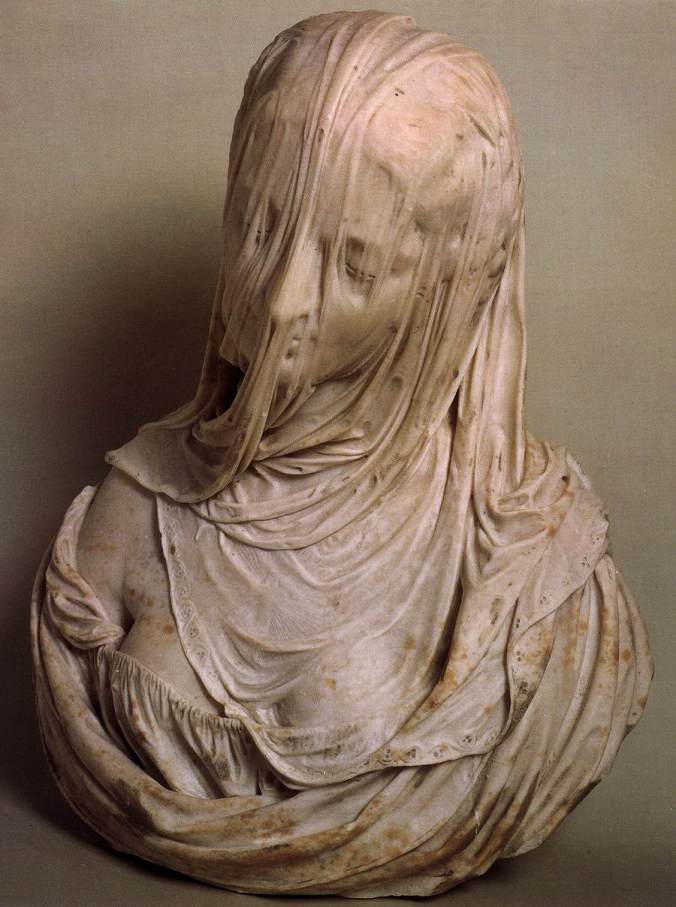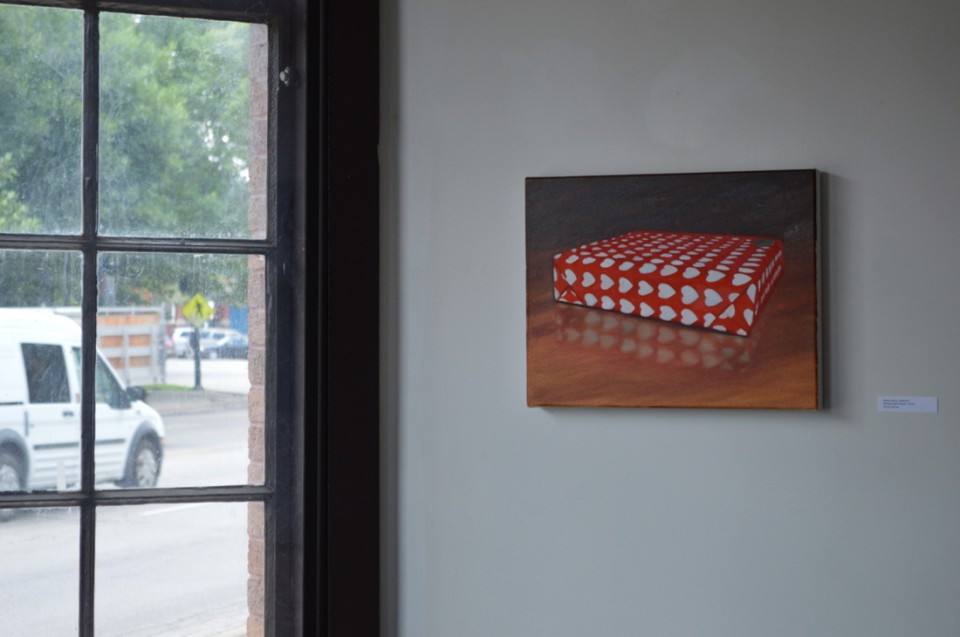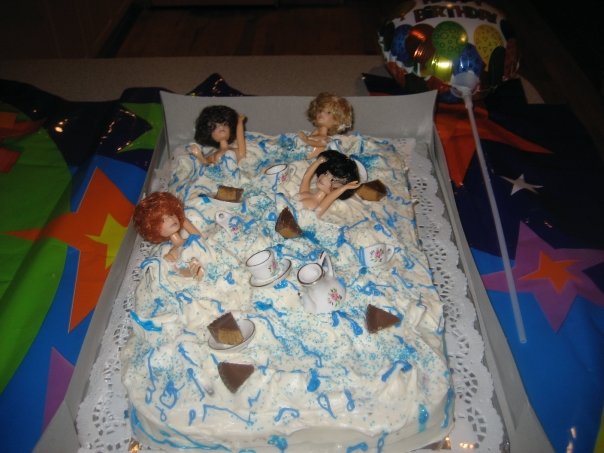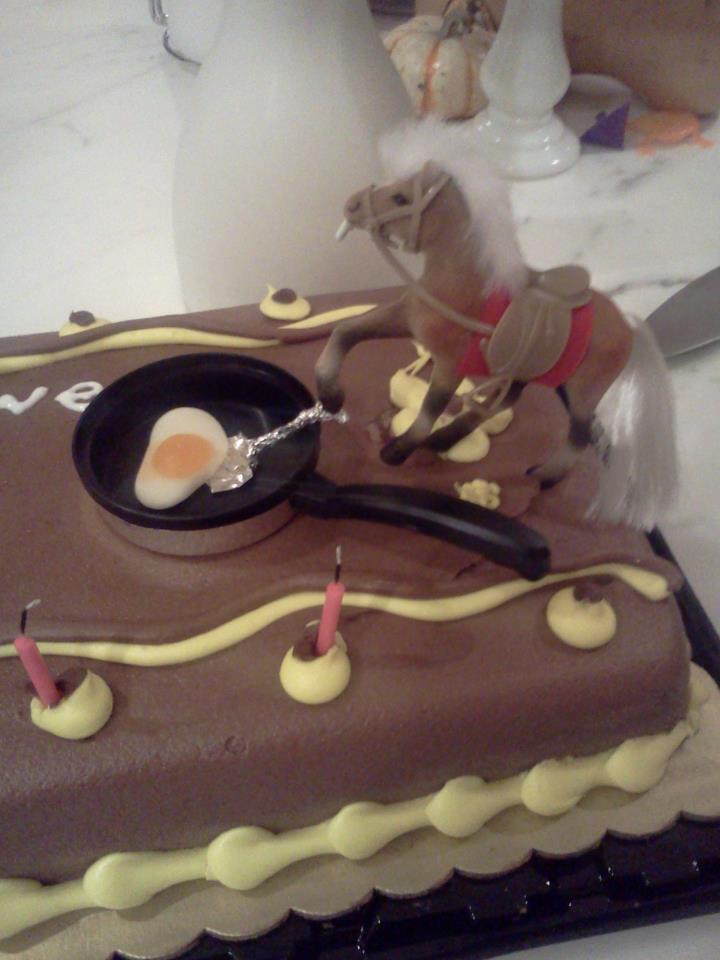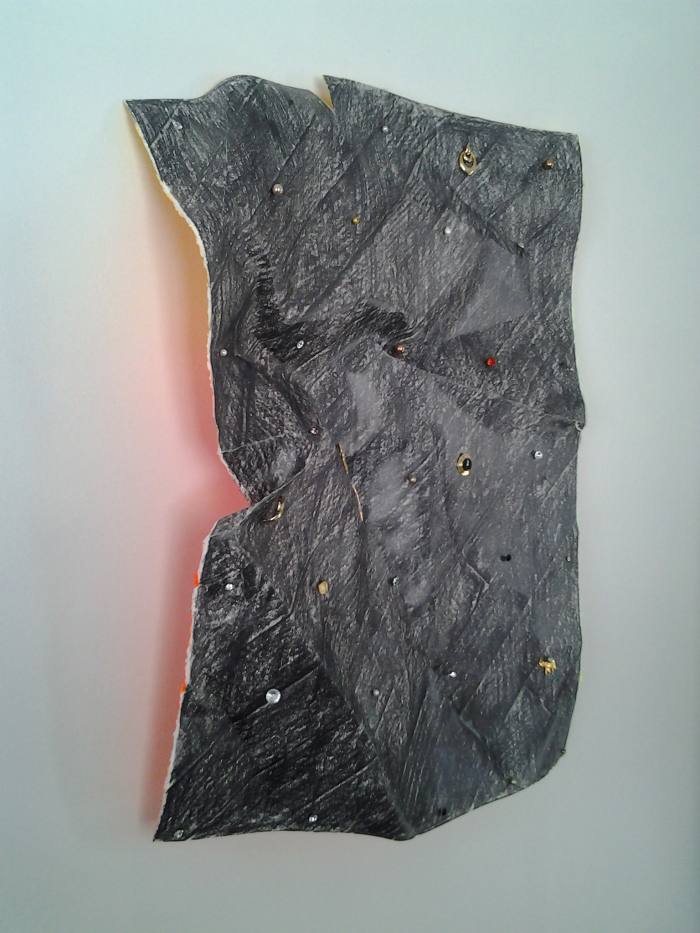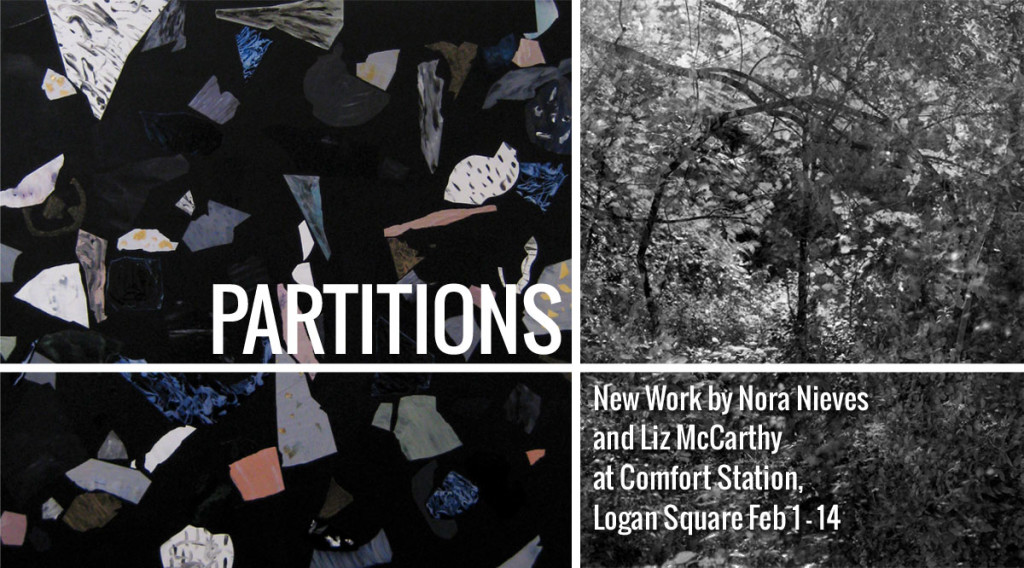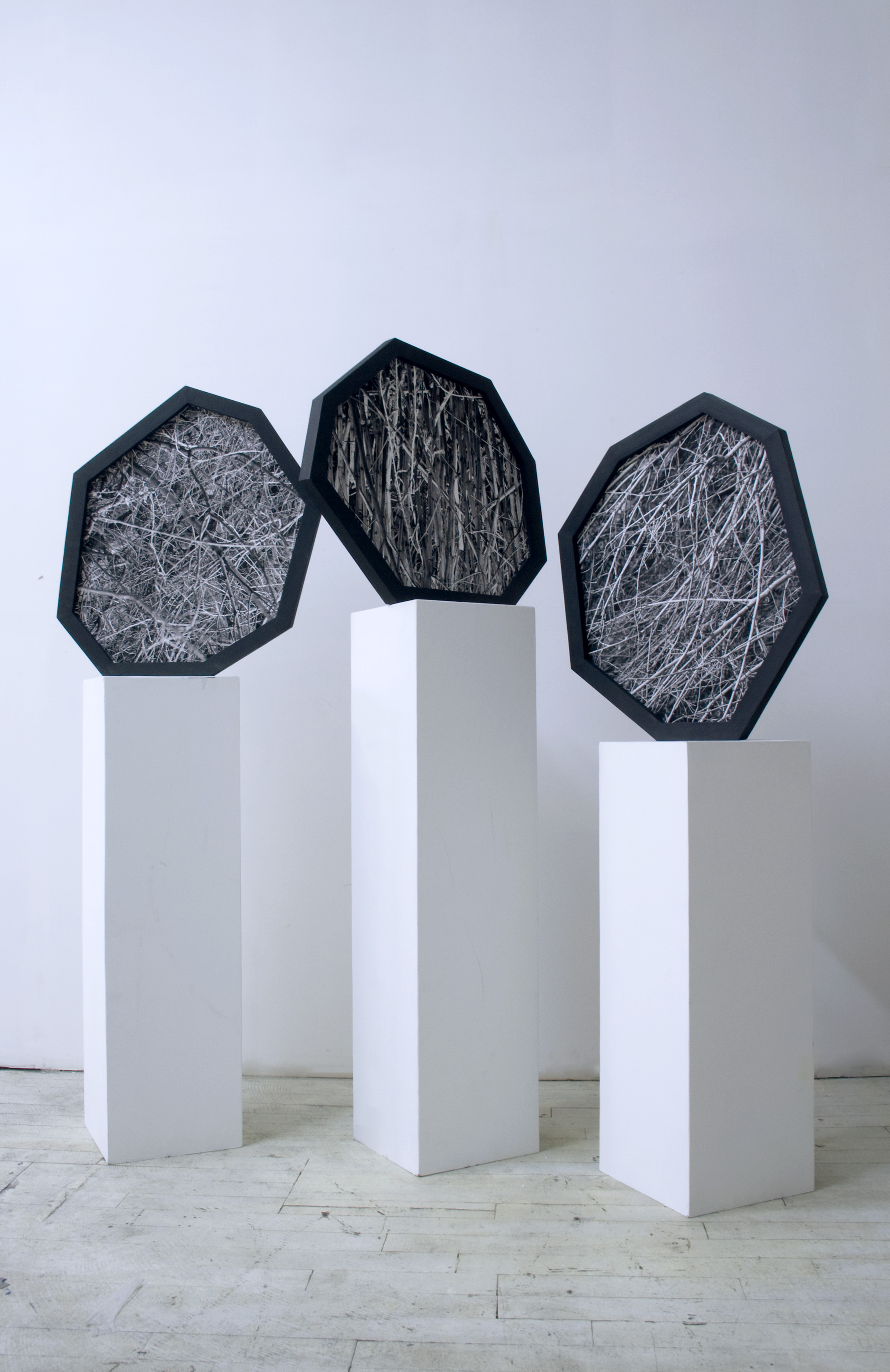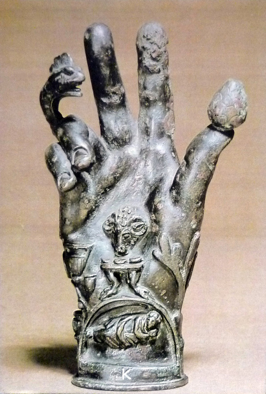Show: Graft
1.) What kind of artist do you consider yourself?
My work moves easily through many materials and processes so I would consider myself an interdisciplinary, conceptual artist.
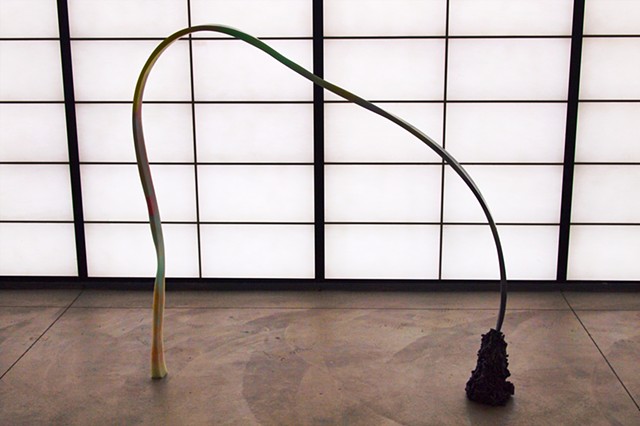
2.) What drew you to Comfort Station, what did you do with the space?
I knew of the space through my friend Jordan Martins. When MK Meador joined the curatorial team there, we talked about doing a show that would be, in a sense, a continuation of the work we were doing together at the HATCH projects at CAC. I was limited to the wall space at CS so I decided to make a new group of wall-mounted work that either literally or conceptually grafted together two crucial points in my life and artistic career, right before the birth of my first child and following my last and second child, wherein I could actively be making and in the studio. Once I had established the conceptual component of my own work, MK and I invited a group of women (many of whom we did not know) to contribute a piece of their own that related to the theme of grafting in any way they so chose. In that sense, it became a curatorial experiment.
3.) What artist from all of history would you like to invite to dinner, and what would you feed them?
I would invite Agnes Martin and my mother, who is also an artist and first introduced me to her work when I was in high school. We would have dinner in my Mom’s garden and I imagine we would feed her a beautiful tea with fruits, salads, cheeses, pastries and champagne.
4) What is your favorite food memory?
I really love sweets and I was determined when we got married to have an excellent wedding cake that was delicious. We asked a baker in San Francisco (our wedding was held at my mom’s house) to make us a really dense coconut cake in the shape of a giant Hostess Sno-ball.
5) What piece of art do you secretly want to steal?
Antonio Corradini’s Bust of a Veiled Woman (Puritas) marble.
Corradini was a Venetian Rococo sculptor. Despite the virtuous parenthetical, I find this piece to be incredibly dark, a woman frozen under the diaphanous veil.
[button color=’yellow’ url=’http://insidetheartistskitchen.com/blog/grilled-cheese-salad/’ target=’_self’] Get the Recipe[/button]
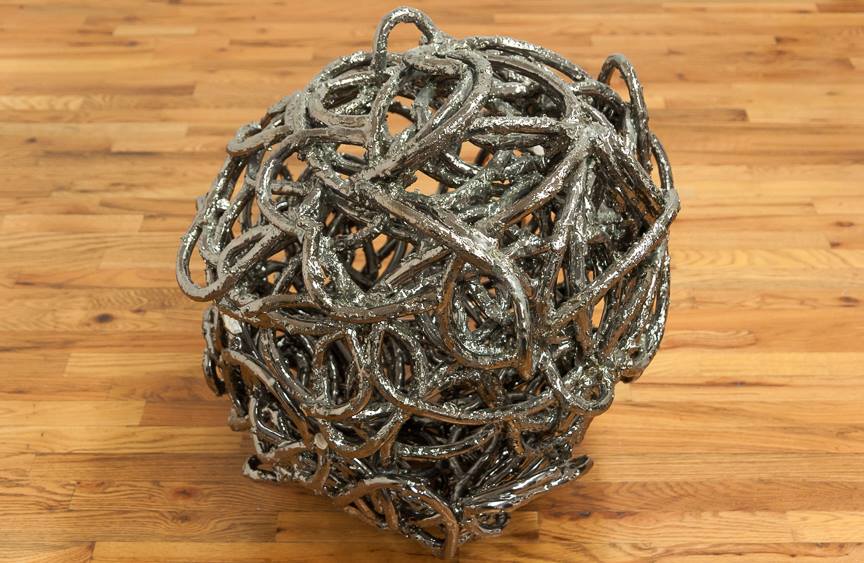
]]>
Show: It Ended With My Putting It On
1.) What kind of artist do you consider yourself?
I think, kindly, I’d consider myself a stubborn one.
2.) What drew you to Comfort Station, and what did you do with the space?
The Comfort Station was a strange experience. Once the show at Linda Warren had come down (December, 2013), I only had about ten months to pull a new body of work together. And I wanted to do something special there, so getting all my ducks in a row required that I work rather quickly and, moreover, take to both a mode of thinking and risk taking that, at the time, kept me mostly terrified and rowing around in my sleep. Regardless of what it cost physically or mentally, this, I think, is really the teeth cutting ethos that Comfort Station is good for; from the very beginning, Jess Devereaux had encouraged me to step out of myself, to coax from the work a life that I wouldn’t ordinarily give it.
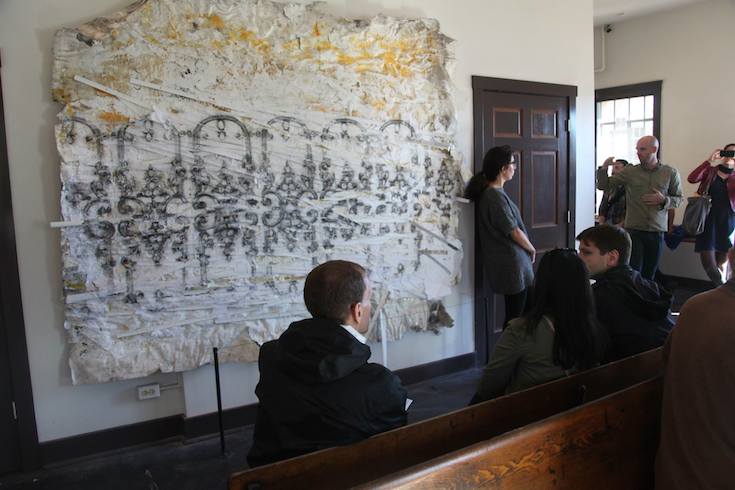
The Comfort Station has earned a reputation in Chicago as a kind of critical darling, and, personally, it has always been very special to me and so I wanted to treat it that way. Of course I had been to plenty of exhibitions there, some unruly and unexpected, some not, and I think the last thing I wanted to do was come in and hang pictures on the walls and call it a show. Not that there’s anything wrong with that, it’s just plainly not your conventional exhibition venue– it presents you with some severe spacial restrictions that you can certainly either take or leave, but I think taking them can result in really bizarre and revealingly imperfect work. Everything I made that year had in mind particular Comfort Station walls and windows, had in mind where particular objects sat in the space itself, like the long benches and the piano and the little decorative iron window grate in the bathroom and the way the old door frame ornament moved. The work was made deliberately beholden even to the way the sun landed on and moved along the building. The work either behaved with it or it didn’t, either way it made apparent certain considerations within the buildings layout which may have been the viewers wont to consider resolved or ignore. For me, the entire experience revolved around working within those restrictions, both as formal devices and behavioral materials, and, in the end, it undoubtedly became a body of work specific to The Comfort Station space and building.
The Comfort Station had given me a chance to really put my money where my mouth is as far as some ideas I have about architecture and the built environment are concerned, and indeed I was intent on making that happen. I didn’t think, however, that I’d ever put so much shoulder to the wheel. This show changed a lot of things for me.
Also, from the very beginning this show was a collaborative effort. For a long time JR Robinson of Wreckmeister Harmonies and I had talked about doing something together, making work that specifically reflected one another. And so when I finally got around to asking him to be a part of this, he was more than gracious and enthusiastic and just fell right in. I, in turn, spring-boarded off some things he had written prior. There is no end to architectural imagery that recounts the marriage of music to form, they are likely and handy bedfellows, and so I had a lot of history to draw from there. JR came up with a stunning and unnerving wall of a movement. It was a lot to listen to, like everything he does, beautiful and overwhelming and it washed throughout the show as if it pressed out from the work itself.
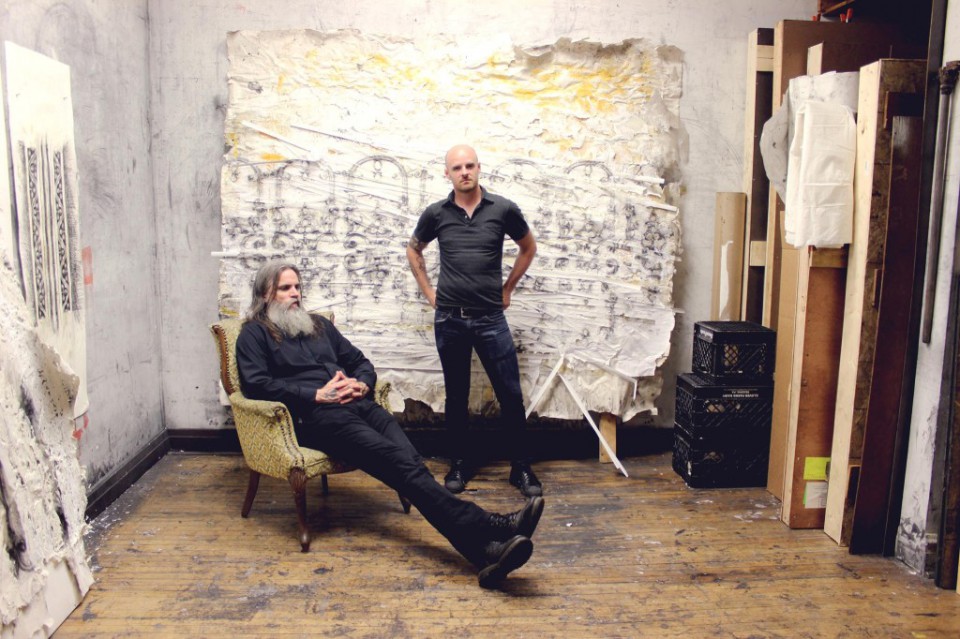
3.) What artist from all of history would you like to invite to dinner, and what would you feed them?
From all of history I think I’d have Joan Mitchell over. Besides just being in the same room with her (which I imagine would have been, on its own, a dense and powerful experience), I’d also like to know how she managed to navigate Abstract Expressionism, the contentious, hot bed Boys Club that it was. And I’d like to know, from her perspective, how it all came apart then, what she thinks is happening to us now.
Anyway, I’d feed her my famous New Years Sauce, a hearty and homely pasta sauce which is made up of a base of different kinds of tomatoes (usually cherry, plum, and Roma), red and yellow pepper, a jalapeno, a head of garlic, a stalk of rosemary, olive oil, italian sausage and bacon fat, red onion and a couple chopped carrots and a bottle of cheap wine. It sits and simmers for about ten hours, whence everything melts into a stew and its delicious on New Years.
4.) What is your favorite food memory?
My mother is an incredible cook. A warm Norman Rockwell type, and growing up she found as much comfort and stride and solace in the kitchen as she did in her own children. She’d come up with the kind of meal where the table is burdened and there isn’t any room to actually get any eating done. She’s a severely loving and strong and frustrated person, and so her food came out like work. And growing up she’d sometimes make these hugely elaborate, low-lit spreads with her Saturdays or Sundays, but it was Thanksgiving that she’d call off the holds and we’d eat all day long and into the next. Food was treated like the godly American Muscle that it is on this day, and we were respectful of its bounty and always humble and grateful.
5.) What piece of art do you secretly want to steal?
This is a wonderful question. If I had the opportunity to go and steal something I think it’d be Max Mulherns’ gift to the people of Samothraki; a copy of The Winged Victory of Samothrace, intended to replace the original, which was excavated and taken away to the Louvre in the mid-nineteenth century, where it has remained. When the Louvre refused to return the piece, Mulhern made the people of Samothraki a new one, which they did accept as a gift. Unfortunately however, the Greek government stiff-armed his attempt to install the gift at the site where the original Winged Victory was first plucked out of the earth.
Stealing it would, of course, require a lot of digging, since the gift never made it and was instead buried in a field by the Aegean sea.
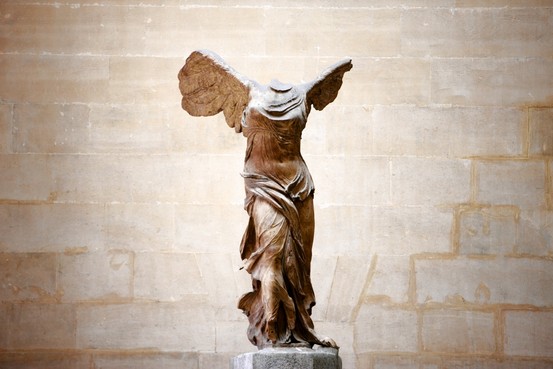
[button color=’yellow’ url=’http://insidetheartistskitchen.com/blog/fancypizza/’ target=’_self’] Get the Recipes [/button]
]]>
*Gwendolyn also works tirelessly to bring art to her community with the South Logan Arts Coalition.
[button color=’yellow’ url=’ http://insidetheartistskitchen.com/blog/manitaropita/’ target=’_self’] Get the Recipe [/button]
Show: Partitions
1) What kind of artist do you consider yourself?
I consider myself a maker and an interdisciplinary artist. I work in different mediums and disciplines, but I think my ideas and influences are more attached to a painting language.
2) What drew you to Comfort Station, and what do you plan to do/what did you do with the space?

Last summer, I was a sponsored artist at High Concept Laboratories in Chicago. HCL wanted to showcase the two sponsored visual artists from the summer of 2013, Liz McCarthy and me, in collaboration with Comfort Station. Liz and I were very excited to show our work at Comfort Station because the architecture and history of the space was related to our work.
Comfort Station was a space to rest, wait, and find comfort from weather conditions and the hard Chicago winters. Now, Comfort Station is a space of reunion and cultural exchanges, but in some ways still a space to find comfort. Our show Partitions intended to bring together our two artist visions. We document environments by making structures that tentatively define the way in which we experience particular spaces. Liz explores the exterior and I explore the interior.
Liz McCarthy works through a process of submerging herself in naturally occurring landscapes in an attempt to alter and document her own durational experience. I create methods for recording material space though simple gestures like making graphite rubbings of walls and floors, building arbitrary columns with bright colored hand-crafted tiles, and creating structures that draw attention to existing structural elements of a room. I pay attention to architectural elements and décor from many places I’ve lived in and experienced to understand how we define space through our domestic ownership.
We had the opportunity to have a conversation with the guests as part of the events of the show. Nicholas Wylie was invited to be the moderator of the conversation, and he suggested making the conversation more of a performance experience. We both agreed. A performance conversation makes sense because of the nature and relationship of our work with the exterior and the interior. We started inside Comfort Station and walked around it from the outside to have a better understanding of our own different practices and how we observed our surroundings. I think it was a very honest and intimate experience, and it gave a sense of space and time that are imbedded in our work.
3) What artist from all of history would you like to invite to dinner, and what would you feed them?
I think I would like to invite Eva Hess, and I think I would prepare a vegetarian dinner, but if I could choose, I would prefer to invite her for a Sunday brunch. I think I am better making breakfast, and I would be able to make my special coffee! I love eggs and coffee.
4) What is your favorite food memory?
I think one of my favorite food memories is preparing “pasteles” with my grandmother at her house. I was probably 7 years old. Pasteles are basically Puerto Rican tamales. They are made out of a mass of yautía, plantain, and pumpkin filled with ground beef, chicken, or bacalo, then wrapped in a plantain leaf with a thread around it. Then you have to boil them, and they’re ready! The best source of calories ever!
She made them to order. So, when she had a lot of orders, she transformed her big dinner table into an assembling line of pasteles. That’s when my two little hands came to play. My grandma gave me the ingredients, and I went one by one placing them in each pastel. I enjoyed helping her so much, the tasks felt like a game. I have very fresh the image of the dinner full of pasteles in my mind; I think I should make a painting of it!
5) What piece of art do you secretly want to steal?
“Hang Up” from Eva Hess. That is one of my favorite pieces. The understanding I have of painting as an object came after that piece.

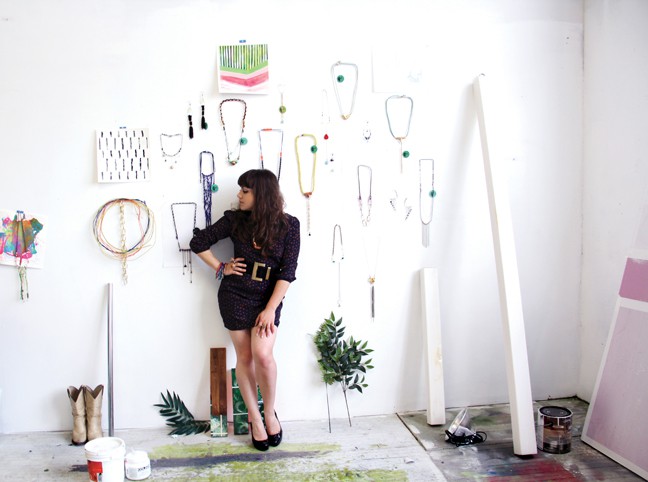
[button color=’yellow’ url=’ http://insidetheartistskitchen.com/blog/comfort-kitchen-verde-salad-mofongo/’ target=’_self’] Get the Recipe [/button]
]]>
Show: Wait for Now
What kind of artist do you consider yourself?
I can remember being about eight years old messing around in my grandfather’s garage. He was a plumber and had all of this great stuff around all the time. I would make these little sculptures out of pieces of pipe and old coffee cans and twine. I would hold on to them for a while, but they would inevitably end up in the trash. To everyone around me, they were trash. I had no idea assemblage was a thing.
I went to a very academic undergraduate college and didn’t major in Art. I didn’t even really start to think about making art on a serious level until I was in my last year of undergraduate studies, when I took my first printmaking class. Printmaking changed everything. It allowed me, someone who has always been creative but for the life of me can’t draw a still life or a portrait, to make images I was really happy with. When I entered graduate school, I was only making prints. Once I gained confidence in my printmaking work, I began exploring sculpture. When I left graduate school, and didn’t have easy access to a printmaking studio or a woodshop, I began painting and drawing.

I have a degree in the History of Art, and because I was so involved in thinking and writing about art before I was serious about making, it really affects the way I create. I definitely consider myself a multidisciplinary artist. I always start with the concept. Sometimes that idea needs to be a painting, a video, or an installation. Sometimes it might be a sculpture, a print, or a performance. As long as my concept is sound, I try to not limit myself as to what form the work takes.
What drew you to Comfort Station, and what did you do with the space?
I love making site-specific work, especially in unconventional spaces. The history and architectural features of Comfort Station really appealed to me. I grew up an hour north of Philadelphia, in a slightly depressing, but very old and historical small city. The house I grew up in was built in the late 1800s and was in complete disarray and falling apart when we move in. Things were built differently a hundred years ago. Comfort Station is so beautiful and eccentric. I wanted to make work that didn’t compete with that quality, but embraced it. I considered both the history of the space, and its current inception as a community arts center.
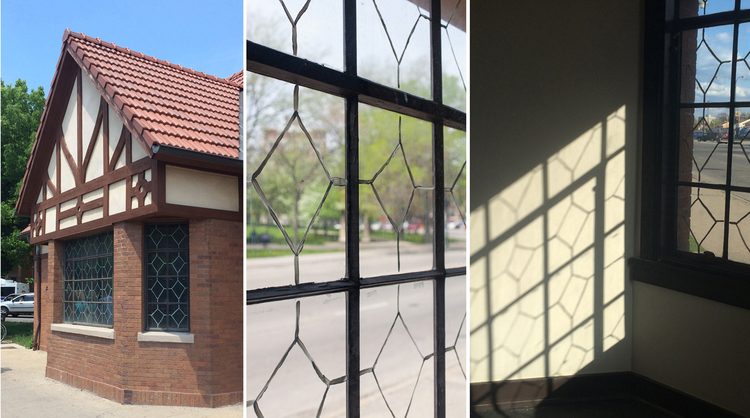
There are several pattern based pieces in the exhibition that took inspiration from both the building itself and old railway maps from when Comfort Station was operational under it’s original purpose. The windows are painted, so that from the inside you see Logan Square through a pattern that I’ve created, transforming the landscape. Seen from the outside, the pattern informs the other works.
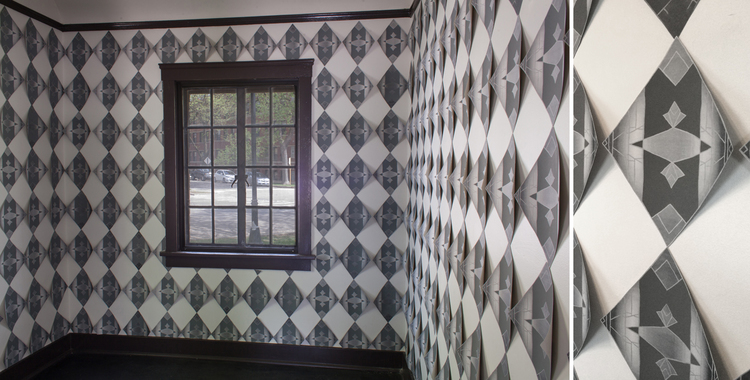
The small back room is wallpapered with cut out diamond shaped prints. Printed offset from a hand drawn image, and then screen printed, the slight color variations highlight the significance of imperfections. The room itself has two windows, both different sizes and at different heights. Identical but uncut copies of the prints are available as a free takeaway, with text written by Emanuel Aguilar on the reverse.
There are also several painting and leaning sculptures included in the exhibition. The largest sculpture includes and eight foot live tree, which will hopefully be planted outside of Comfort Station when the exhibition closes. I also created a piece specifically for the piano that is always present, welcoming rather than ignoring Comfort Station’s mission as a community space.
What artist from all of history would you like to invite to dinner, and what would you feed them?
Robert Gober. There’s an absurdity and playfulness, but also a gravity and seriousness about his work that I think would translate into wonderful dinner conversation.
I would feed him a traditional Sicilian American meal that would make my Noni proud. There’s a level of ridiculousness to the way we eat, where it takes so long you need breaks between each course, but it’s also so lovely. There’s no rush. The food is delicious, but the focus is the people you’re with.
We would start with cheese and sundried tomatoes, maybe some salami or prosciutto. I would also make squid salad, which is one of my absolute favorite things to eat. A green salad, then pasta with a light tomato sauce followed by chicken cutlets and broccoli rabe and eggplant. It would end with coffee, nuts and fruit. I would have hours to ask him questions.
What is your favorite food memory?
When I was younger, there was no celebration too small to throw up a tent in the back yard, make a ton of sausage and grill them with peppers while some uncle was playing the accordion in the back ground.
Every Friday night during the summer, the Castel Club held a bingo night. The Castel Club is a social club, mostly frequented by Italian immigrant families where I spent a lot of time as a child. People had wedding receptions there, first Holy Communion parties, and bocce tournaments. We had the reception for my grandfather’s funeral at the Castel Club. My grandfather would take me there after a day of watching him fix people’s plumbing problems and I would sit at the bar while he and ten other old men with names like Frankie, Johnny, Vinnie, and Fat Charlie would talk for hours.
I have pictures of me, barely four years old, cranking a pasta machine, but there are rules. Certain people make certain things. It was a huge deal, when a few years ago my Noni decided I was ready to fill the cannoli. I was probably 26. I wasn’t allowed to MAKE the cannoli, just fill them.
On Fridays at the Castel Club the kids would run around helping determine who actually had won, confirming the correct numbers when someone yelled “bingo!” One Friday, however, I was called back to the kitchen. For whatever reason that night, I was going to help make the sausage. I remember feeling so unbelievably important, sticking my hands deep into an enormous bowl of pig intestines. I had seen sausage made a million times in that very kitchen, but to be the one actually holding and twisting gave me such a feeling of pride. We still have huge family dinners when I’m home, and I often host “family dinners” here in Chicago, and that look of pure happiness when someone is enjoying something you’ve cooked still makes me feel that same satisfaction.
What piece of art do you secretly want to steal?
Fifty Days at Iliam by Cy Twombly. It is ten individual canvases that are permanently installed in one room at the Philadelphia Museum of Art. I remember walking in for the first time and being so totally and completely overwhelmed. The monumental scale of the work and the ferocity and sensuality of his created language had a huge impact on me. Without really being aware of it at the time, I was definitely influenced by Twombly’s use of literature and history.
[button color=’yellow’ url=’ http://insidetheartistskitchen.com/blog/comfort-kitchen-gnocchi-wpesto/’ target=’_self’] Get the Recipe [/button]
]]>Show: Partitions
What kind of artist do you consider yourself?
I am a photographer, but I am a cheater and combine the medium with whatever is appropriate to explore perceptual behavior. I make photographs to serve as objects and catalysts.
Statement: I am interested in the constant negotiation between the self and an exterior environment. I believe humans are in a continuous process of taking in, analyzing, and synthesizing our surroundings to create symbols and narratives that define our identity. I explore my personal experience as a reference, and mostly use photography to document the emergence of my own perceptual behaviors. In the studio, I re-interpret these photographic documents by intuitively combining them with object making. The culminating artwork is a record of the phenomenological action of “seeing” space and time and “reseeing” by way of reacting to that initial document.
What drew you to Comfort Station, and what do you plan to do/what did you do with the space?
The show at comfort station was organized by High Concept Laboratories, specifically Rachel Ellison. I did a residency there last summer, and “Partitions” was the follow up exhibition with Nora Nieves, another artist in residence. The pieces in the show were all emblematic objects exploring alternative ways of visually representing time and synthesizing landscape. All these pieces were interested in the perceptual process of taking in one’s surroundings and reducing or formalizing an experience into a representation. One of the main pieces that encouraged a lot of work in the show was a found diagram drawing of the earth moving around the sun dated 1929.
I was interested in how this diagram still remained as a relevant way for our culture to visualize our relative placement in time and space. I made a reproduction of this drawing because it is the same model I imagine when visualizing the earth rotating around the sun, a simple ubiquitous text book symbol of the motion that effects all earthlings. Most of the work in this show was also using variations of a dodecagon shape (a twelve sided polygon). I like this shape because it is the lay out of a clock and can be a representation of the 12 months calendar year. I built this structure large scale to photograph, and manipulated the shape in simple drawings.
What artist from all of history would you like to invite to dinner, and what would you feed them?
Carl Jung. Yeah yeah, you think he is not an artist, but he created a really amazing manuscript of illustrations as a young man of symbolic forms and narratives. This manuscript, a study of his own psyche, is reflected in his theories throughout his career. Art is philosophy. We would do something casual for dinner. Maybe grab some comte cheese, baguette, sausage, and three bottles of red wine. We would sit under a tree in a park somewhere, eat, drink, and hash it out until it started raining or one of us passed out from the drink.
What is your favorite food memory?
Cooking with my dad. He is the worst because he doesn’t eat processed sugar, meat, cheese, gluten, alcohol, and like five other things depending on the direction of the wind. I spent my summers with him as a child. During these two months of one on one hangout time, we experimented with lots of weird combinations of food that would satiate my kid taste and his bizarre dietary restrictions. Usually these took the form of some combination of beans, rice, cumin powder, and ten different vegetables. Later in life I have heard similar such concoction described as “Hippy Mash.”
What piece of art do you secretly want to steal?
I guess as an artist that makes objects, I sort of become uninterested in actually owning objects. I think the making of the objects is more interesting, and I have amassed too many of my own. So I will tell you about the objects that I want to make. I am currently obsessed with a William Wegman piece “Basic Shapes in Nature” where he made a mask of the Bauhaus style circle, square and triangle, and stood in different landscapes. So in one image he is on a mountain with the triangle on his head, and another he is among rocks with white circle on his head.
 A lot of my work is influenced by anthropological artifacts/art. Most recently I have been really into Roman cult of Sabazios/Dionysus ‘Hand of Power’, a symbolic hand decorated the symbolic objects associated with that cult following. Not much is really known about the exact use of hand, but I am interested in the way the bodily object is taking on the symbolic qualities of whatever the ideology was. I have been replicating similar hands with clay.
A lot of my work is influenced by anthropological artifacts/art. Most recently I have been really into Roman cult of Sabazios/Dionysus ‘Hand of Power’, a symbolic hand decorated the symbolic objects associated with that cult following. Not much is really known about the exact use of hand, but I am interested in the way the bodily object is taking on the symbolic qualities of whatever the ideology was. I have been replicating similar hands with clay.
[button color=’yellow’ url=’http://insidetheartistskitchen.com/blog/hippie-mash-massaged-kale-salad ’ target=’_self’] Get the Recipes [/button]
]]>Show: Fieldnotes
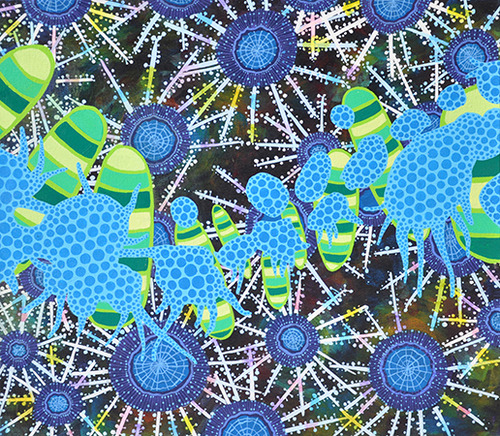
What kind of artist do you consider yourself?
I’m the kind of artist that works all the time and I live each day like it’s my last. I might die tomorrow. I’m constantly making new pieces and thinking about all the work that I want to make. I define success by the amount of quality work that I make. I’m really driven to create, and it’s my entire life. My canvas and panel works are made with acrylic, and my works on paper utilize a combination of ink, gouache, colored pencil, and graphite. I also rent studio space at Spudnik Press Co-op where I can use the printing press and materials to create etchings and screen prints. It’s a maker space where artists can pay each time they go to utilize the equipment. Either I’m creating or I’m going to art exhibits. I typically attend 5-10 art exhibits each week and I’ll attend more if possible. I really get a rise out of experiencing art, and I think it deeply informs my practice. There is nothing more exciting than going to an exhibit and seeing a body of work that an artist has spend the last 1-3 years preparing for.
What drew you to Comfort Station, and what do you plan to do/what did you do with the space?
I’m very excited to be showing a new body of work in a non-traditional community-driven art space. It’s really fantastic that CS also doubles as a performance venue. To me the space looks a research station in the middle of a city, and that inspired the creation of all new work for the show. There is a historic quality to the space that is really fascinating. Comfort Station also hosts musical and film programing throughout the month of April. Films are screened on Thursdays, and musical acts perform every Wednesday. It’s thrilling that there will be so many other events happening in the same space as my art exhibit.
What artist from all of history would you like to invite to dinner, and what would you feed them?
For my dream dinner with Dr. Seuss, I would prepare a Cuban feast that includes salad, avocado, Maduros, Tostones, empanadas, grilled shrimp, marinated pork, black beans and rice, and perhaps flan for dessert.
What is your favorite food memory?
Every Sunday night, my friends get together for a potluck. Everyone brings their A game, and a fantastic feast happens. It’s really incredible. We did carnival/fair foods one evening that included Chicken and waffles on a stick, pigs in a blanket, nutella funnel cakes, chicken wings, cole slaw, pickles, salad, calzones, corn on the cob, and deep fried corn dogs. This happens every week. It’s absolutely incredible, and I have pictures.
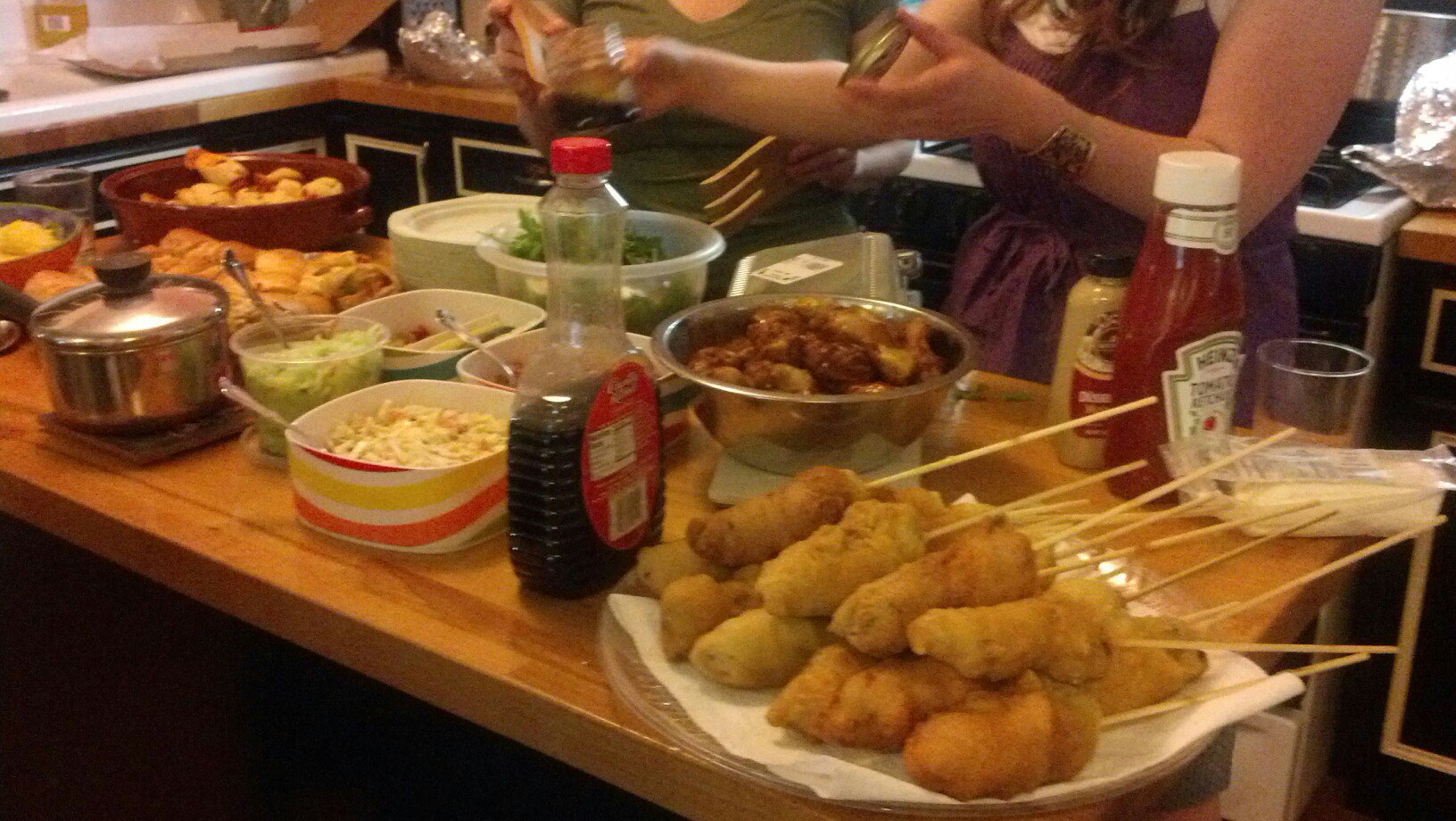
What piece of art do you secretly want to steal?
I would die for a Jessica Joslin sculpture.
[button color=’yellow’ url=’http://insidetheartistskitchen.com/blog/comfort-kitchen-pretzels-wbeer-cheese’ target=’_self’] Get the Recipes [/button]
]]>Curatorial Board: Jessie Devereaux, MK Meador, and Robyn Paprocki
Interviewed by Kristina Daignault & Michael Soto
History
Curatorial Process
Programming
Balloons
On the word artist
History
Kristina: I actually don’t know how long Comfort Station has been Comfort Station. You kept referencing, “I’ve been there since the beginning,” tell us, “When was that?”
Jessie: The space has been around since 1915, and it was originally a stop on the old Milwaukee tram, and there were literally hundreds of these little cookie-cutter buildings that ran along Milwaukee. They were all torn down, and this space was left standing, then it was used as city storage for forty years. The windows were boarded up, and it was stuffed with hedge cutters and lawn mowers and whatnot, and at that time, from what I hear from people who have lived in the neighborhood for fifty years that I’ve gotten to know through being in that space, they all thought it was haunted.
Logan Square Preservation is an organization in the neighborhood who takes care of the houses and the maintenance of some old buildings, and literally will picket the destruction of these old buildings. Really, ground-level active, trying to keep the neighborhood lovely, and they’ve done a really wonderful job. So they worked it out with the city in 2010 to start renovation and restoration of Comfort Station.
K: Wow, so that was pretty recently.
J: Yeah, so they took it over and brought back a lot of the old detailing in the interior and redid the exterior. They put a lot of time and energy and money into the restoration of the building. And then there was the big neighborhood conversation about what happens then. It was discussed whether it should become a retail space or a coffee shop, and so there was some kind of neighborhood tussle about what was going to happen with this space.
K: That would have been a sad use of it.
J: Exactly. And Logan Square Preservation felt really strongly that they wanted it to be a community art space, and so they brought David Keel on, who’s [now] the director. David is an artist, and he’s been active in the art world in Chicago for a long time. He took it on with his two buddies. One of them was my downstairs neighbor when I moved back from Los Angeles. This is all kismet. I was downstairs at this house party, and I was talking to David Keel, and he was like, “Yeah, we have this gallery space, and we don’t really know what to do with it,” and he said, “We really need some help. Do you want to come curate a show?” And I was like, “Absolutely.” Because that’s what I did in LA, and I was really excited about the idea of getting to do it here.
And so I came in for one show, and I just never left. We opened up for our first show in April 2011, and the first show was Jordan Martins who is a musician and also did the free jazz series for The Whistler. During his show, he said, “Can I curate these music series every Thursday during the show to bring more interest in?” And we were like, “Absolutely.” And it was such a hit that we just continued ever since then. So the first show was his work, and he started doing this every Thursday, and it just never stopped.
Robyn: And it should be said that Jordan Martins has amazing collage work.
J: He does. He’s a brilliant artist. It kicked off with this really beautiful show, and it’s just been a combination of serious hard work on everyone’s part. Back to the legend about the space being haunted. At this point, I think it is. I think that it’s good spirits. It has this amazing presence to it, that space, and it lends an air. All the programming that goes on in it, it’s very unique. So in any case, we’ve been really fortunate that the quality of the artwork and music and film that have since come to be in that space have all been very good.
We’ve developed a reputation for that. And then we realized that we needed to build out the fine arts programming. We talked to these two very capable lovely ladies to join the curatorial panel in 2012. Robyn brings in a huge amount of knowledge and connections in the design world, so we’ve broadened our base from fine arts into the design world, and then MK is incredibly really well connected in the Chicago art world and is a very brilliant writer. Everyone really brings their skill set to it, and it allows for a greater depth of programming. We want to be diverse, we want to be accessible, present as much variety as we can, especially in the neighborhood, but in the community at large.
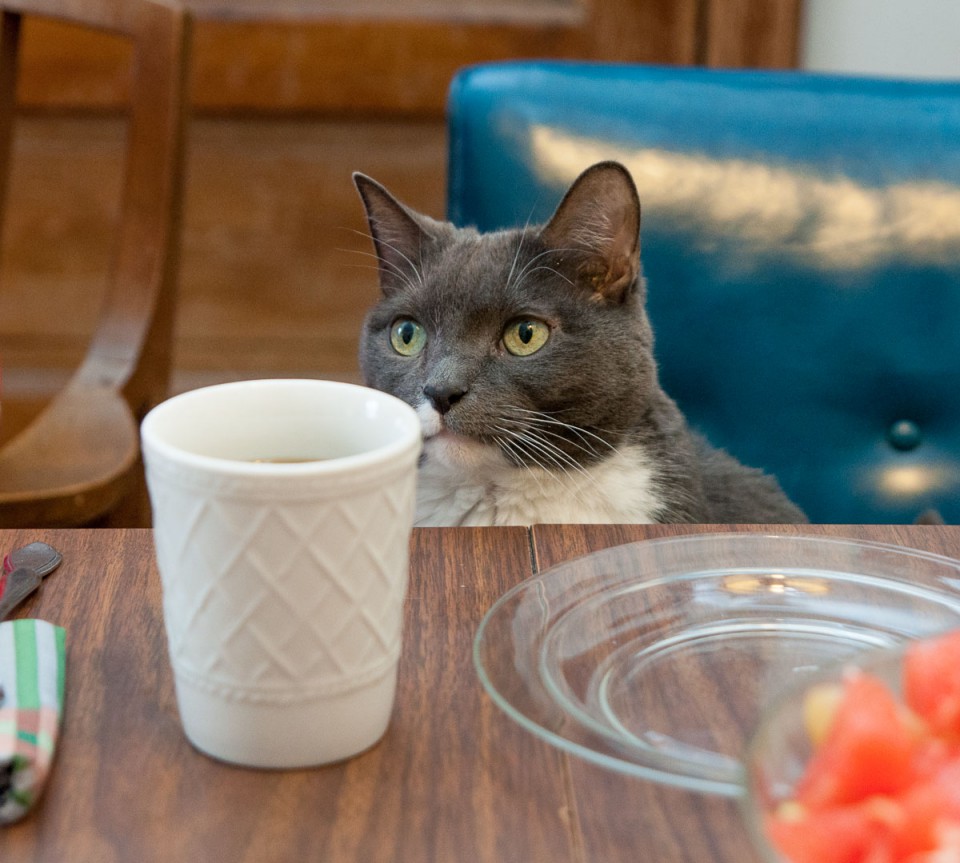
Curatorial Process
K: How do you decide who curates each show?
R: We usually do a call for submissions and also bring our own ideas in. We look across the board at what kind of artist we want for the space, what their work should be like, who they are as people, geography, and across the board, we just try to get a really nice diverse group.
J: And even though we have our own specific shows, we actually do things kind of collaboratively. We’ll bounce the press release off of each other, or if someone needs help doing an install, we’ll pop into the space. We’ll support on opening reception day. We’ll always collaborate in some way, but there’s always a lead point person for each artist.
K: Besides the fact that you said that you are looking for a diverse range of people, are there certain qualifiers?
MK: We’ve definitely learned the hard way that new new media, projection has lots of logistical things to consider.
R: It’s really hard because it’s a historic space, you don’t want to destroy the walls. There are limits to what you can do. The other thing is we have so much programming that we like to have some kind of visual tie-back to the artist in the space during all the shows. So if there’s a musician performing on Thursday night, we can’t necessarily turn on the projections too because it might interact with what the musician is trying to do in not a great way. So we try to get that balance between what the artist wants to do with the space and how the other programming can react to that.
J: This is an idiosyncratic space, so a lot of time, we receive these proposals from people that are like, “I do 12 x 12 paintings, and I have five of them. How can I show that?” And I’m like, “It’s not really the space for you.” So a lot of the time, there has to be adaptability on the part of the artist, and there has to be adaptability on the part of the curator. And actually, MK has done a lot of really interesting things to bring large-scale works into that space.
MK: I built a wall. I had this vision: As you walk in, confronted with a wall-sized work. This artist who has these wall-to-wall charcoal drawings of the same word written over and over and over again, and it was kind of playing off the discomfort as well. This idea of it being a shelter for travelers and messing with that with the confrontational work. There’s a window there, and we had to have a wall over it to present the drawing.
K: So we were just there. I really liked the presentation of the photographs on the pedestals by the window. I thought was a really unique way to use that space. To me, they echoed “window.” I don’t know if that was your goal or if you had anything to do with them specifically?
MK: No, I wish I could take credit. They kind of self-curated, those two artists, as part of High Concept Labs. Well, the artist who you admire, Liz, has curated a bunch in addition to her photography. She, I think, nailed it. She just laid that whole thing out.
And she’d been working with the other artists for years, and she knew the work. That work had a really subtle read that I didn’t pick up, but talking to her, there’s all this stuff about time and ephemera. I think it’s really really awesome. She did custom-build those pieces for that window, I found out.
J: A lot of artists have done that–seen the space and are like, “Actually, you know what we need right here…” and then they’ll end up responding to the space. It ends up being this collaborative.
K: That’s actually really good.
R: And I think that ties back into the spirit of the space that you were talking about earlier. It definitely talks to you when you walk into it. You get a sense of the history, and you get a sense of what has been there before.
Programming
J: And really the exciting thing about how the space panned out is that we’ve brought on these curators to take on these other programs who are just as immersed into what they’re doing. It’s not like we’re on the side like, “Oh, let’s show a film. What can we show?” It’s this whole other group of people that are geeking out on what they can fill that space with.
K: I totally agree with you. We happened to pop in to meet you during a film series, and there were two guys setting up, and I don’t know if they were the people who run the film series or some extra helper people, but they alone were generating enough buzz about whatever movie was playing. And then there were people popping in like, “Is it time for the movie yet?” There were like six or eight people by the time we met with you, and it was cold. I think it was October, and it was cold, and people were still really amped up to see whatever was happening. So I think that it’s true that it’s a place where people with a lot of different interests, no matter what you’re into, there’s something for you to see there or do there.
J: Yeah, also we have the food program that started last year, which has been really an interesting addition to the space. Because food, you know, is very accessible. And then we have a lecture series that started last year that’s supposed to be “Casual Conversation” is the trademark of it. It’s not supposed to be this stand-offish academia. It’s supposed to be this conversation-based lecture series called Comfort Society. And also, we have things like the Chicago 16mm Film Archives that show once a month that are incredible. That’s pretty much part of the space too, is giving a venue to these series that are looking for a home.
R: For March, they’re working with the Post Family to bring this set of films that was created by Logan Square artists in the 70s and 80s that are a showcase of the Logan Square-centric home movies found in her collection. And then they’re doing a series of home movies after that. So they’re asking people to bring in their home movies, and it’s kind of like an open-mic home movie night.
J: That’s fantastic. I love that a lot. I didn’t know that until right this moment, and I love it.
R: Yeah, and I think it’s a lot about building… this is a perfect example of how we try to build a community in the space. The sacred harp is an example of that, too.
J: Do you know sacred harp singing? It’s like shape-note singing.
Michael: Oh, ok. Yeah.
J: So, we have a series that’s twice a month, every other Saturday. In the summer, it’ll kick off again. It’s like, “If you come, you have to sing.” You can’t just listen. It’s all shape note, so you’re responding to the shapes. There’s a brief tutorial, “This is how this works.” Also the idea is that you sing at the top of your voice. So it’s this grand cacophony. And the acoustics in that space are so fertile, so it’s this amazing, booming… it’s wonderful.
MK: It sounds really beautiful sometimes. Have you seen the movie Cold Mountain? There’s a scene in there in the church, and they’re singing going like this, and they’re singing Sacred Harp. That’s the only example I’ve seen in a movie. It’s so good.
M: I don’t know the history of shape-note singing. I just know that the tradition’s still there in the modern Episcopal hymnal and some of the other hymnals.
J: Yeah, it’s interesting. That has been a real draw from all over the city. “Shape note series?” They’ll come out.
K: It’s a little weird unique niche thing.
J: And that’s one thing, we’re always open to the proposals. They’re all considered. We actually have a guided meditation series starting again this year that we’re doing that I think will also be bi-monthly.
Balloons
MK: Yeah, we had a Vernau show. He had balloons in the small space. That was like a freak-out zone.
K: I will confess that balloons in general, I think make everyone happy. I don’t know if this is the same artist or if it’s just similar work happening at the same time, but there was also a piece at a gallery in the water tower, which was just a room filled with balloons, and it was getting a lot of talk.
J: Were there forms, or were there just balloons?
K: I’m pretty sure they were just balloons. But I think the balloon thing is going on a little bit lately, and we happened to see in Garfield Park in some basement gallery. It’s called GAG, Garden Apartment Gallery, and the lady who runs it is awesome. And we always see very unexpected things there. I’m always really surprised. A little while ago now we went there, I can’t remember when, but there was a room full of balloons and fans, and we ended up playing. We all stared at each other for a minute, like, “Is it appropriate for grown-ups to play in the balloon room?” And then we’re all, “we’re doing it!” And then we’re all playing in the balloons.
J: That totally reminds me of when we first installed the Belknap show. I don’t know if you’ve seen images of it, but there were like twelve hundred meteors that they cast out of foam on these pieces of standing wire on the yard. So they were in these rows, and David had just finished helping them install these thousands of meteorites, and I come from brunch, and I’m like, “This is amazing!” I literally took off running and went like this through the field, they were all bouncing around, I was running back and forth.” He’s like, “I don’t know if…” I’m like, “OK, I get it.” But then in the end, it was great because all of the kids would come by and interact and play, and people were really participatory.
R: I actually did a small little thing for the You Are Beautiful tenth anniversary that had balloons in it, too. You’re absolutely right. And when I was doing that installation, this guy came through, and he was like, “Oh my god, I do balloons, too.”
K: There’s lots of balloons happening. People are responding to them, which is probably what’s keeping it around. People just really like balloons.
R: There’s this whimsy that’s associated with… all it takes is one twenty-five cent balloon filled with helium, and people are happy.
J: I actually want to show you guys this. It’s a little bit of a tangent, but I keep this thing around because it makes me think that… Look at this, “Emerald green, five inch balloons, 15¢ each.” I just love the visual of that.
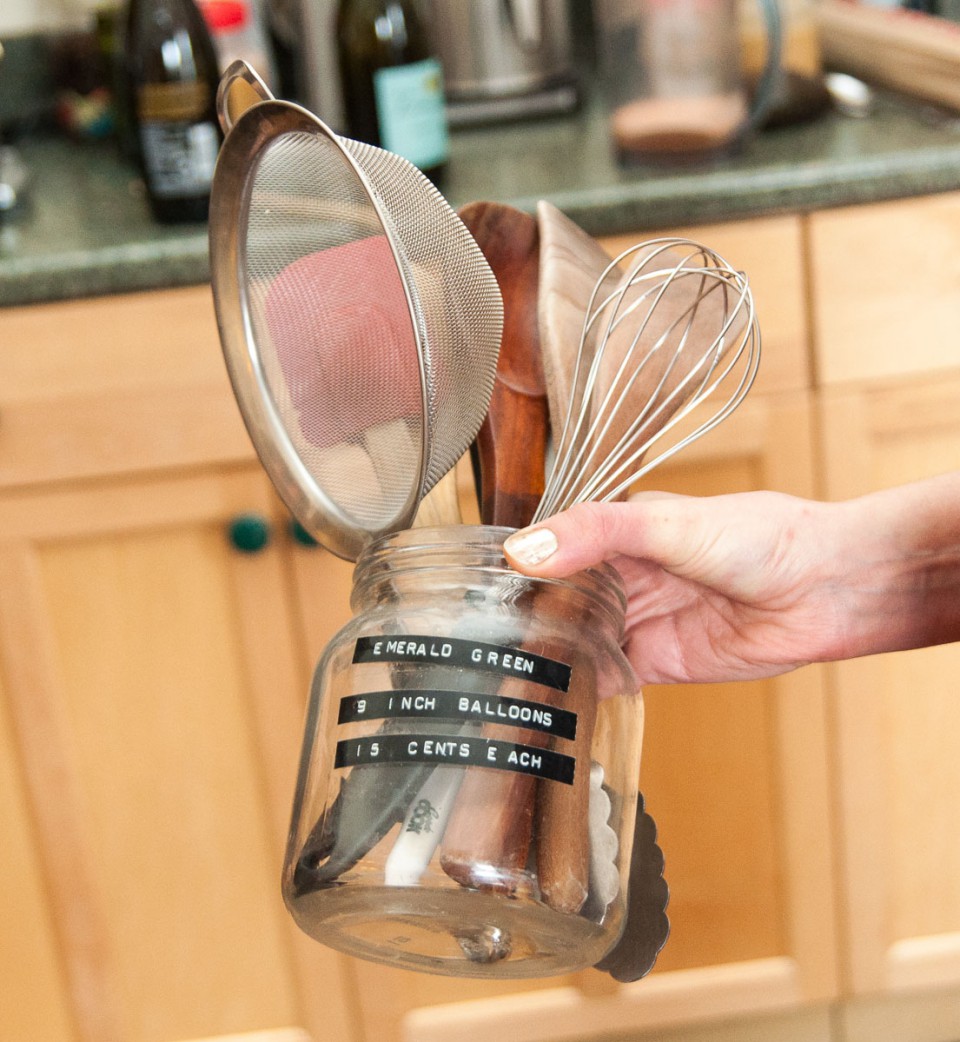
K: You got it at a thrift shop?
J: Yeah, and so I always keep that on there. I just love the visual of 15¢ emerald green balloons.
K: That’s nice. I think you’re right, whimsy is the right word.
K: I usually ask people, “What kind of artist are you?” during all of my interviews, but I feel like maybe, “Are you artists?” might be more apt right now?
R: Perhaps, “What kind of curator are you?”
K: Sure. What about you?
MK: I’ve become almost militant about my use of that word. I think it’s something that people call you, you don’t get to call yourself that.
K: Really?
MK: I couldn’t call myself that. I hope that one day somebody might see what I do as valuable in that way, aesthetically, to call me an artist. But I guess the safe way to say it is I’m a writer. I think that’s intrinsic to any curating. Writing is a huge part of it. I hope one day, I could be an artist. It’s not that writing is not art, but I don’t do it in a way that’s departing a whole.
M: What kind of writing do you do?
MK: On my own, I do a lot of fiction writing, but I don’t show that. But a lot of just collecting of things, and I’m going to go to grad school at some point, so I’m starting my thesis, and that’s all about installation artists, particularly 20th century female installation artists. I’m just combining things for that. Mostly non-fictive, lots of press releases. Lots of press releases.
M: So you’re a researcher as well?
MK: I guess, yeah.
R: I don’t consider myself an artist. I’m trained as a designer. I guess I do art pieces occasionally, but I call myself a connector, and I think that the term “connector” works in many different ways. I’m a connector of people, I’m a connector of ideas, I’m a connector of visual assets.
MK: I like that a lot.
R: Thank you.
M: We had one artist that we interviewed who made this off-hand remark to Kristina about the difference between an artist and a designer is that “Artists are willing to get their hands dirty.”
R: Yeah, and I think there’s this other difference in that designers work with clients. It’s kind of a collaborative thing, whereas artists are either commissioned, or they create a piece and someone purchases it. Designers work with clients, and they also do more strict typography, the kind of typographic theory that you want to follow if you’re a designer. You’re right, though, artists get their hands dirty a little bit more than designers do.
K: I think there’s also the level of when you’re a designer, you’re responding to something that’s for more than yourself. I think when you’re an artist, you work from a place within yourself to express something. But those are maybe arbitrary meanings I’ve attached to the words, but I feel like it’s a different place that you create from, so I don’t know if you can say that one’s dirtier.
R: As part of being a connector, part of what you do is give people a platform, so all of the things that I do, wherever I’m at, my goal is to create a space for people to express themselves, and whether it’s people who already have work that exists out there or work that I have to invite them to think about and create for us, I really enjoy giving a platform, and there’s nothing better than the opening night when you can see how people are reacting to the work that you think is so great. You can see people get goosebumps by the same things that give you goosebumps. They think, “Oh my god, they get it! It’s so good!”
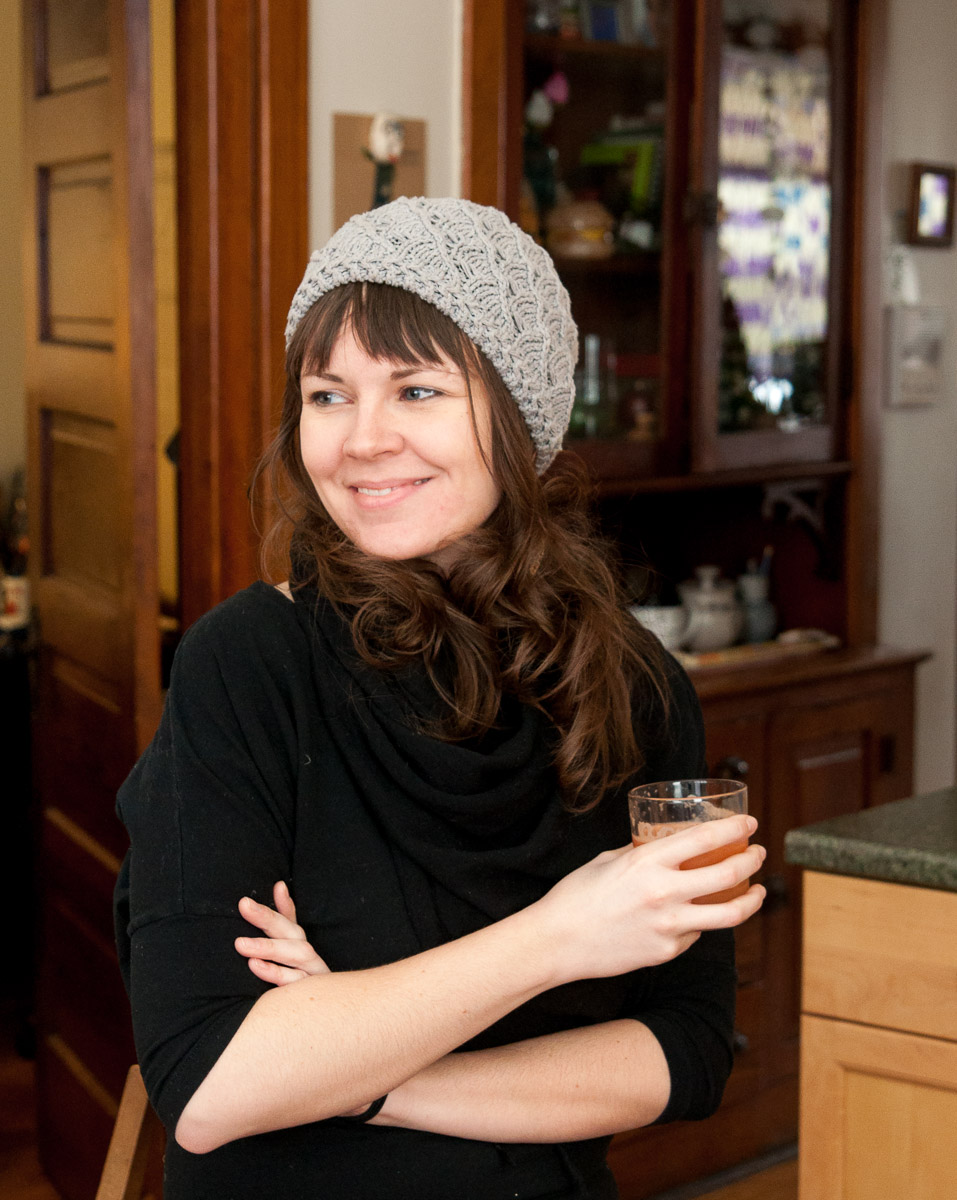
J: That gets a high five in my book.
K: I don’t think we’ve had the chance to have that kind of reaction. I hope that our project eventually gets big enough that it does things like that. Bridges gaps and connects things.
J: It’s amazing how things can be subjective that you keep in mind and they come to fruition when you’re not looking. You’re like, this is what I want, and suddenly you’re so busy, a couple of seconds later you’re like, “Wow, that’s happened.” It always incarnates itself in a different way.
R: Are you an artist?
J: Well, Robyn, I went to art school. I went to the Art Institute and studied painting and printmaking. Since then, I make things for myself and as gifts, but my real public art has been curation ever since then. I absolutely do think I would consider myself an artist. I think without that title, I would be very lost in the world. I think it’s very much how I think and how it allows me to interact with other people—in traits that I look for in other people socially. You know I’m a collector. You can look around my house, and you can find something, and I’m like, “Let me tell you about that thing.” So I respond to objects, and that’s what finally drove me to curation, was finding some nuances in objects and finding correlated nuances in other objects, if it’s found objects or in different artists. And while I was in Los Angeles, I was working in the gallery system more professionally, and I started noticing these commonalities and then independently started bringing them together in shows, and that was my favorite thing, is not only having people come from the outside and be like, “What a curious thing,” but also juxtaposing work together in a way that artists would come in and be like, “I didn’t even consider my artwork in this way until I saw it in this context,” and that’s another one of my favorite things, finding these similarities that are put into these works and then bringing them together to create this other narrative. I also very much like the atmosphere, how much these works enrich an atmosphere and create this dialogue or this experience for the viewer that should push you out of what you’re normally thinking, what you’re normally experiencing and put you in this awkward moment where you have to reanalyze. In any case, the answer is, “Yeah.” And my mom, too… I’m kind of just like her in this really funny way. If you go over to her house, she has all these… she’ll have an avocado pit growing roots in a little jar on the windowsill, and then she’ll have a little Buddha with a little leaf just sitting next to it. Nothing really makes sense, but it’s just things she found curious and put places. And so the nut doesn’t fall far from the tree. She’s very much an artist in her own way as well.
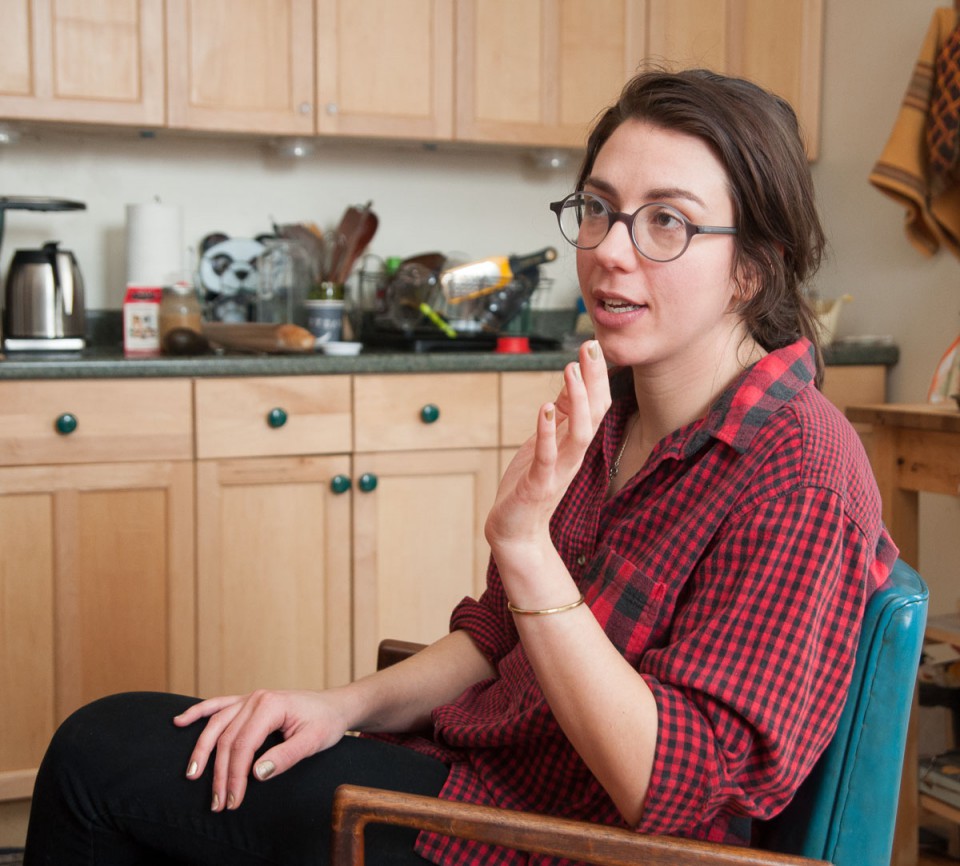
R: I like that, “The nut doesn’t fall far from the tree.” I don’t even use the word curator that often. I say that I aspire to curate. It’s a constantly evolving learning process, and I feel the same way that MK feels about the word artist. I feel like people call you a curator when you’ve proven that you can do the job. So that’s why I call myself a connector.
MK: I never feel like I’m achieving something that hits as “art” because it could always be better.
K: Every single thing that we’ve done, we always step back and think, “Oh god, if that was only 2° higher, my life would be so much better.”
M: But also, I’m not trained as a photographer, I went to school for music, and I feel the same way about the word “photographer.” I don’t call myself a photographer because it’s something that I’m figuring out along the way.
J: I think there’s something to those labels that’s inherent to you. Training is a wonderful thing, but I think you can call yourself a photographer when you clearly have that talent and you do it actively.
MK: But there’s still some part of it that’s so private… that’s still for me. And that’s the part where I don’t want to show too much, or I don’t want to flaunt, because it’s still a personal practice for me. So… exploration.
R: I was talking to a curator the other day who divided it in two sides of the same glass. One of the sides is the very personal, informed in what’s happening right now… being able to see these connections, but then the second half is what you were speaking to earlier, it’s like this history. Some curators have both halves, and some curators only have one or the other. It’s just tuning the dial to exactly where you need to be to get a platform for the people and build this narrative.
]]>